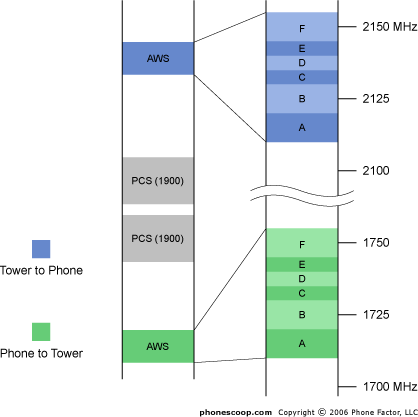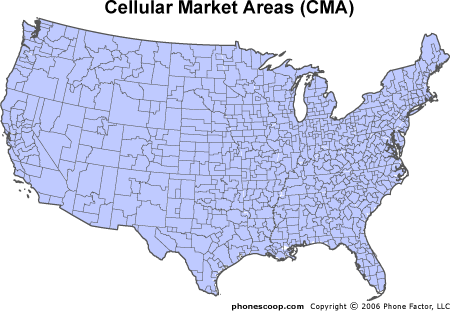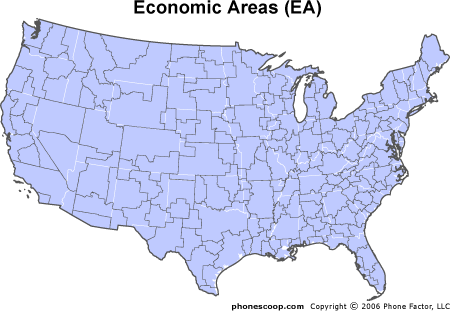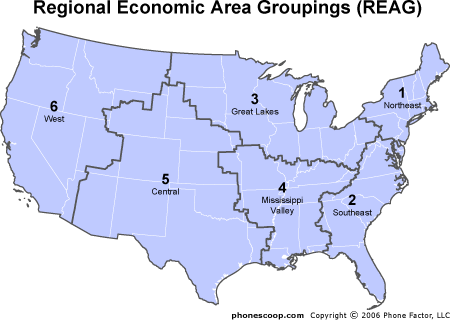A Visual Guide to AWS
Each "band" of spectrum is sub-divided into smaller "blocks". For AWS, the blocks are divided as shown below:

One important thing to note is that some blocks are larger than others. When it comes to AWS, the A, B and F blocks are each 20 MHz wide, while the other blocks are only 10 MHz. That means the A, B and F blocks have twice the capacity, meaning they can potentially handle twice the number of simultaneous phone calls, or twice the data throughput.
Since this is paired spectrum, the A, B and F blocks technically consist of 10 MHz for tower-to-phone, and 10 MHz for phone-to-tower. The C, D and E blocks only consist of 5 MHz in each direction.
None of the AWS licenses are national, though. Rather, the AWS band is not only divided by block, but also geographically. Each license that was sold at auction was for only one block, in one area of the country. Over 1,100 individual licenses were for sale in the AWS auction.
To make things even more complicated, the geographic divisions are not the same for each block. Some blocks are divided up into just a few very large areas, while others are divided up into hundreds of small areas.

The map above shows how the A block was divided geographically. The divisions are based on CMAs (Cellular Market Areas,) of which there are 734.
(If you've heard of MSAs and RSAs, those are the same as CMAs. MSAs are simply metro areas, while RSAs are rural areas.)
When the FCC sold licenses for Cellular service way back when, it was also based on CMA divisions. That's probably one reason why the FCC chose to offer one block of AWS spectrum divided by CMA: so that smaller companies with existing Cellular licenses could buy new spectrum that matched their existing coverage area.
The FCC also has a duty to use its regulatory power to protect small businesses. Offering AWS licenses that cover relatively small areas is a way to let small local companies get started and expand in wireless.
The B and C blocks are divided geographically into EAs (Economic Areas):

EAs are the medium-size geographic divisions within AWS, being larger than CMAs but much smaller than the next category. There are 176 EAs. (EAs are sometimes also called BEAs in FCC lingo.)
When the Cellular and PCS bands were auctioned off, most cell phone companies were still local or regional. In those days, small divisions of radio licenses made complete sense. But these days, most cell phone service is offered by national carriers, so licenses covering tiny areas complicate things unnecessarily, and, well... just seems silly.
To reflect this new reality of the wireless industry, the FCC decided to auction off half of the AWS blocks based on a new, super-size system of REAGs (Regional Economic Area Groupings.)

REAG is how the D, E and F blocks are divided. There are 12 REAGs total, but only six main REAGs for the whole continental US. Other REAGs cover Alaska, Hawaii, Puerto Rico, etc.
(REAGs are sometimes also called REAs in FCC lingo.)


 iPhone 15 Series Goes All-In on USB-C and Dynamic Island
iPhone 15 Series Goes All-In on USB-C and Dynamic Island
 iPhone 16 Brings More Features to All Price Points, Including New Camera Control
iPhone 16 Brings More Features to All Price Points, Including New Camera Control
 Hands On with the Boost Summit 5G
Hands On with the Boost Summit 5G
 Apple Watch Series 9 Detects Finger Gestures, Brings Siri On-Device
Apple Watch Series 9 Detects Finger Gestures, Brings Siri On-Device
 Google Now Lets You Search with Camera + Voice
Google Now Lets You Search with Camera + Voice

